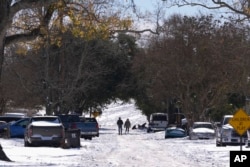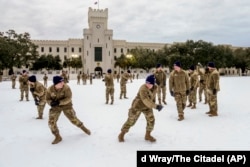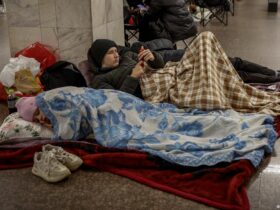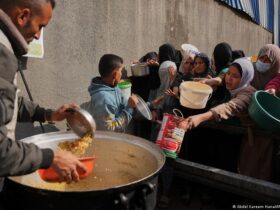Days after the winter storm caused snow and record-breaking snowfall, cleanup efforts were underway Thursday in several major Southern U.S. cities such as New Orleans, Louisiana, where crews were removing snow in the same manner they did after Mardi. Garbage, drink cups and plastic beads were removed. Grass Festival.
Temperatures were slowly rising across the US South, which was expected to melt remaining snow and ice.
“We have to be honest with ourselves — we’re from Louisiana, we know crawfish, we know football, but we don’t really know snow and ice and that’s OK,” said Daniel Gitlin, a spokesman for the Louisiana Department of Transportation and Development. ” “It’s going to go away and we’re better off letting nature do what it needs to do right now.”
Gitlin said up to 320 kilometers (200 miles) of interstate highways were expected to remain closed through Friday due to dangerous chunks of black ice. He said the salt supply in Louisiana is almost exhausted after treating the roads.
In New Orleans, a private waste management company has been contracted to repurpose equipment that is typically used to clean snow from streets like Mardi Gras beads and cups.
Sidney Torres, president of IV Waste, said his company has deployed a 15,000-litre (4,000-gallon) “flusher” truck to spray water on the ground to remove snow in the historic and festive French Quarter. “The truck usually sprays a lemon-scented scent to get rid of the odors of last night’s alcohol, urine, vomit,” Torres said. “We are looking for new solutions and better technologies to deal with this.”
Louisiana Governor Jeff Landry said Arkansas sent Louisiana snowplows, dump trucks, salt spreaders and other equipment.
Record likely to be broken due to snowfall
The snowfall is expected to break several records across the region, including in Florida, where initial reports of 25 centimeters (10 inches) in one city, if confirmed, would set a record for the state.
Savannah, Georgia, received a total of 8 centimeters (3 inches) of snowfall this week, the most snowfall recorded in the state’s oldest city since December 1989.
Snow was light in metro Atlanta, Georgia, where the southern suburbs saw more snow and ice than northern areas of the city. In Covington, southeast of Atlanta, Jesse Gentes used a flame thrower to clear snow from the roads in his subdivision. He told television station WSB-TV that in better weather, he usually uses a flame thrower to remove brush.
Light freezing rain was expected Thursday in the port city of Brunswick and surrounding Glynn County, where local officials imposed an overnight curfew due to icy roads and frigid temperatures. Officials opened three warming stations where people could escape the bitter cold, and about 4,000 residents of the county were still without power as of Thursday afternoon, according to PowerOutage.us.
South Carolina reported at least one death in the storm. A 71-year-old man died from a medical condition while shoveling snow Thursday morning in Berkeley County, Coroner Darnell Hartwell said. According to the National Weather Service, about 8–10 centimeters (3–4 in) of snow fell in the area.
The snow and ice had staying power and left slush on roads in coastal South Carolina. In Charleston, South Carolina, snow melted and then froze overnight, closing the James Island Connector, a bridge that connects the city to its western suburbs. Police said on social media that “although staff are working hard, it is unlikely to reopen any time soon.”
Schools and county offices remained closed as officials in much of the area south and east of the state capital, Columbia, told people to stay home for at least another day.
It was a similar story in North Carolina, where slick roads remained a danger to drivers after the snow melted and then froze overnight. Schools were also affected, including in Cumberland County, where Fayetteville is located, where the school system announced that students would have an “asynchronous” learning day, allowing students to complete assignments at home. Many other school districts operated with a two-hour delay.
Some school systems in central and south Alabama were closed Thursday due to snow remaining on roads or the possibility of frozen pipes in schools. In coastal Baldwin County, sections of Interstate 65 and Interstate 10 were closed due to snow.
Throughout the South, airports were slowly recovering from weather disruptions. Nationwide, nearly 600 flights into or out of U.S. airports were canceled by Thursday afternoon, according to flight tracking service FlightAware.com — a marked improvement from previous days when the storm was at its peak.
parts of the river freeze
Meanwhile, in the Northeast, places like New York were still battling bitter cold, despite moments when the sun peeked through the clouds.
Parts of New York’s Hudson River turned to ice on Thursday amid recent cold weather in the city. The frozen surface broke into blocks of ice and the grand skyline of the city became visible on the far bank of the river.
The National Weather Service has issued a wind chill warning for eastern parts of the US. In New York, the city is facing temperatures below zero degrees Celsius (about 20 degrees Fahrenheit), which are expected to last through the weekend.
Some material in this report is from Reuters.








Your point of view caught my eye and was very interesting. Thanks. I have a question for you.